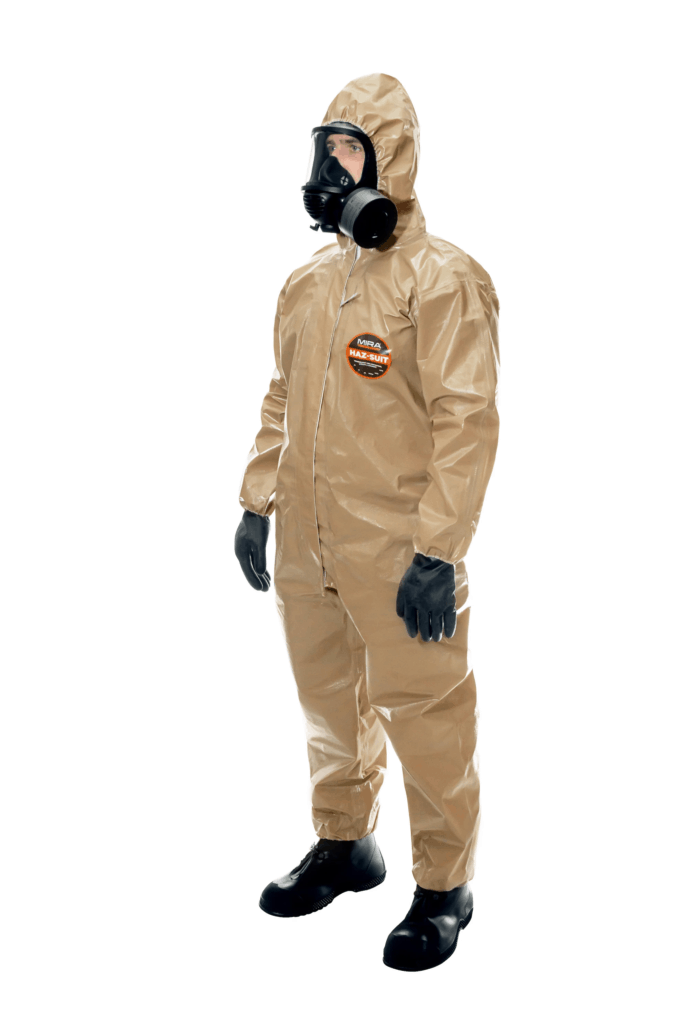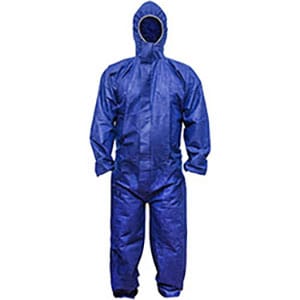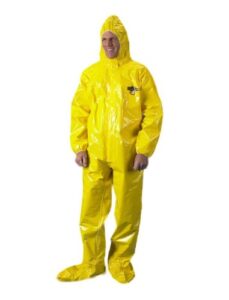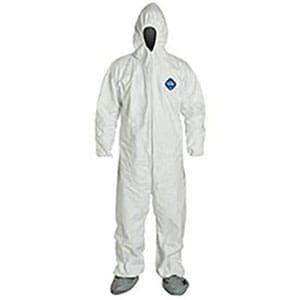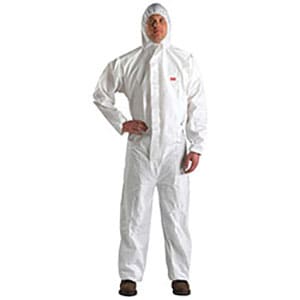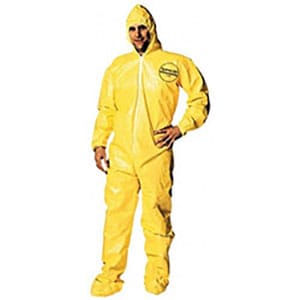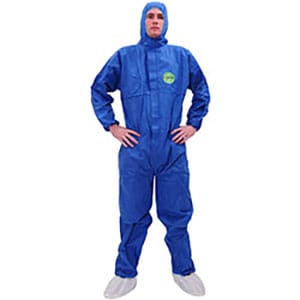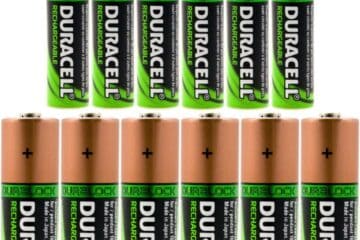Whether it’s a news story of the ongoing cleanup at the Fukushima nuclear power plant or one of healthcare workers attempting to get a handle on the latest virus outbreak, the one constant is the presence of the hazmat suit. Hazmat suits are a commonplace today. But it wasn’t always so.
It was only in the aftermath of WWII, when the threat of nuclear, biological and chemical attack became all-too real, that the modern hazmat suit emerged. Today, there are 4 levels of hazmat protection ranging from fully encapsulated suits that create an independent internal environment, to the turnout gear worn by firefighters on a daily basis. Below, we’ve brought together a cross section of the best hazmat suits on the market.
1. Mira Safety Protective CBRN HAZMAT Suit
Click here for the lowest price
The Mira Saftey Haz-Suit makes no compromise when it comes to hazmat chemical exposures and serious disasters.
This Haz-Suit has been engineered to be one of the most long-lasting, durable, and most flexible hazmat suit on the market today. It provides complete protection from CBRN agents and is a solid solution for the future.
Mira Safety partnered with Kappler, an international leader in personal protective apparel, to produce one of the worlds only disposable hazmat suits offered in a range of sizes, all the way down to children as young as 4 years old. This Haz-Suit is made from fabric that is a durable, puncture-resistant film composite with an excellent barrier to over 125 chemicals including chemical warfare agents (CWA) and toxic industrial chemicals (TIC).
With an extensive chemicals-tested list, the MIRA Safety HAZ-SUIT delivers the ultimate in hazmat protection.
2. Medtecs Hazmat Suit
This pack of disposable hazmat suits by Medtecs is an essential item that you shouldn’t miss. These suits are designed to provide reliable protection against hazardous materials, liquids, and dust. Made of waterproof and breathable material, these suits are perfect for use in a variety of settings, including medical, industrial, and emergency situations.
The suits are easy to put on and take off, making them a convenient choice for any situation that requires quick and efficient protection. Additionally, they feature elastic cuffs and ankles to ensure a secure fit, which means you can move around freely without worrying about any hazardous material penetrating the suit.
3. ABC Chemical Protective Coveralls
These Chemical Protective Coveralls from ABC are a good foundation for those who work with level B chemical and biological threats. They can also be paired with simple goggles and a face mask and used to install fiberglass insulation or protect against contamination in the electronics or food industries.
The suit is made from blue SMS fabric that keeps all manner of chemical and biological hazard at bay. It’s waterproof, flexible, abrasion resistant and very reasonably priced. It’s also surprisingly breathable which really helps on hot summer days. ABC has done their best to keep the cost of this disposable personal protection garment down. To that end there are no pockets and the material is quite light. Hence, the outstanding breathability.
4.Lakeland ChemMax 4 Taped Seam Coverall
The Lakeland ChemMax Coverall Respirator is an essential product for anyone who works in industries where there is exposure to hazardous chemicals and infectious materials. Whether you are working in a laboratory, a manufacturing plant, or in the medical field, this product can help you stay safe and protected.
The ChemMax Coverall is made of a high-quality material that provides superior protection against chemicals and particulate matter. The suit is designed with a hood, elastic wrists, and ankles to ensure a secure fit, and also features an attached respirator hood that provides additional protection for your face and respiratory system. The coverall is disposable, which means that you can use it once and then discard it, eliminating the need for costly cleaning and maintenance.
5. DuPont TY122S Disposable Hazmat Coverall
The TY122S from DuPont is rated to level B but will find plenty of fans looking for something for more mundane chores. You could, if required, slip a respirator on and have a suit that will protect against many biological and chemical hazards. You could also partner it with a good N99 face mask and enjoy reasonable protection from the coronavirus, should that ever become a necessity.
The suit has a full hood with drawstring, elasticized cuffs and ankles and comes with skid-resistant booties. All seams are serged to prevent fraying. On the whole the suit is comfortable, affordable, lightweight and flexible. It’s also a disposable suit. While the need to dispose of contaminated suits is not in question, at least the reasonable price of this suit makes it a little easier to deal with.
6. 3M Disposable Protective Coverall
3M throws their considerable experience with materials and chemicals behind this Disposable Protective Coverall. This is a level C hazmat suit that can be used either with a canister style respirator or an N95+ face mask to provide solid protection against biological hazards and other airborne pollutants. You’ll also get protection from light to moderate liquid hazards.
Although you don’t want to go wading knee deep into contaminated water wearing this. As the name states this is intended to be used and disposed of in order to minimize the odds of carrying contaminants forward into the next day or other areas. In addition, it’s latex-free, anti-static and both shoulders and sleeves feature seamless construction. It also features a low-profile hood that helps prevent snags that could compromise wearer safety.
7. Dupont Tychem Qc Chemical Protection
The Dupont Tychem Qc Chemical Protection Suit will provide level B or C protection from most biological agents, chemicals and even radioactive dust and dirt. Of course, to enjoy that kind of protection you’ll need to make sure you’re wearing the right self-contained breathing apparatus. That said, the suit is a favorite with the food industry. And it’s easy to see why.
It’s light, effective, affordable and comfortable. And it provides head to toe protection while allowing the wearer to retain a high degree of mobility. With the right face mask this would afford comprehensive protection in the unlikely event of a coronavirus outbreak. Or any other type of pressing public health crisis for that matter. It’s also downright cheap if you’re on a budget.
8. Raygard 30303 SMS Chemical Protective Suit
The Raygard 30303 SMS suit is marketed as a chemical protective suit. But with the right respirator it will also protect against biological hazards and airborne radioactive dust. This is a very inexpensive disposable hazmat suit that’s light and seals up tight against the elements. The wrists and ankles are elasticized.
The hood draws nice and tight around the face or your chosen respirator/goggle setup and it comes with a pair of no-slip booties. Waste management technicians, food industry professionals, painters, construction workers, healthcare workers and more will find the 30303 provides the robust protection they need.
9. Baoheng Anti Thermal Radiation Suit
Just to ensure we have all the hazardous threats covered we end our list with the Anti-Thermal Radiation Suit from Baoheng. This full coverage thermal radiation suit will protect from temperatures as high as 500 degrees Fahrenheit.
At the same time it won’t significantly impede mobility or visibility. The suit includes insulated shoes and gloves and can be used repeatedly. What it won’t do is protect against airborne biological or chemical agents.
FAQs
What is a Hazmat Suit?
‘Hazmat’ is an amalgamation of the words ‘hazardous’ and ‘materials’. It is a suit of protective clothing that provides an impenetrable defense against various contaminants. In most cases hazmat suits are used in conjunction with a self-contained breathing apparatus to ensure the wearer does not inhale any contaminants that might be in the air around them.
Hazmat suits are commonly used by firefighters, EMTs, toxic waste cleanup technicians, those who install various types of insulation and more. If you have been keeping up with the news lately you have also seen healthcare workers sporting hazmat suits while dealing with those infected by the coronavirus (1) in China and elsewhere, those dealing with the deadly and ongoing ebola virus outbreak in West Africa (2) and workers cleaning up the site of the Fukushima nuclear disaster in Japan (3).
Hazmat suits can also be used by ordinary homeowners who want to put fiberglass insulation in their attic or who need to use pesticides to clear their property of a tic infestation. Hazmat suits make all of that important work possible. But they also potentially offer frontline defense against known and unknown biological and chemical threats. While no one wants to spend their life tramping around in a hazmat suit there may come a time when doing so means the difference between life and death.
Will a Hazmat Suit Protect Against the Coronavirus?
Yes. As we mentioned hazmat suits are being used as you read this by Chinese healthcare workers battling to contain the coronavirus (4). But while that situation is currently getting a lot of media attention it’s important that the threat of this particular microbe not be overstated. Keep in mind the CDC estimates that between 250,000 and 646,000 people die worldwide every year from what we casually refer to in everyday conversation as ‘the flu’ (5). Tens of thousands in the US alone (6). So keep an eye on the coronavirus situation certainly, but try to keep it in perspective.
Are There Different Kinds of Hazmat Suits?
There are actually 4 different levels of hazmat protection and it’s important to make sure you wear the right one for the occasion. The 4 levels of protection are:
Level A
A level A hazmat suit represents the pinnacle of protection. In essence they create a self-contained micro-environment in which the wearer operates. Nothing is able to penetrate the SMS fabric (7), save some types of gamma radiation (8). The level A hazmat suit provides a full-coverage face shield, a self-contained breathing apparatus, a two-way radio to permit communication, heavy duty footwear and chemical resistant gloves. If a person is using a level A suit it’s because they cannot afford to take any chances. However, for something like installing insulation a level A suit would be the very definition of overkill.
Level B
To the untrained eye a level B hazmat suit may seem pretty much like a level A suit. But there is one fundamental difference between the two. The level A suit has a fully encapsulated breathing apparatus. A level B suit does not. That means that the level B breathing apparatus can be worn on the outside of the suit. Whereas the level A breathing apparatus is completely contained inside the suit.
The level B breathing apparatus still needs to be supplied with air from a tank. But the tank and the mask don’t need to be physically inside the shell of the hazmat suit. Level B suits also require heavy duty boots, typically with steel toes. And a two-way radio will also be required to ensure accurate, timely communication. Once again though, unless you are heading off to Fukushima to help in the cleanup a level B suit is likely to be overkill.
Level C
Level C suits are the most popular type of hazmat suit. They’re worn by everyone from those installing fiberglass insulation to pest control technicians and even those fighting ebola in West Africa (9). These suits provide full body protection from airborne contaminants, including most biological agents, chemical agents and certain types of radioactive contaminants. The major visible difference with this type of hazmat suit is that it doesn’t call for a self-contained breathing apparatus. Instead, people wear a respirator with canister-type air filters. Or they use a particulate mask. This type of suit is cooler, easier to don and remove and is often times disposable. They are also several orders of magnitude cheaper than a level A suit and significantly cheaper than a level B suit.
Level D
The lowest level of hazmat protection is the level D suit. This is typically a coverall that provides some degree of heat protection and/or protection from airborne debris. The typical turnout gear worn by firefighters the world over is considered level D hazmat gear because it does not protect against viruses or chemical agents. Construction workers too can sometimes be found in this type of basic protective coverall.
The thermal suit is another type of level D hazmat suit. They’re considered level D because, although they provide head-to-toe heat protection and look formidable, they provide virtually no protection against airborne chemical and biological agents. The level D suit is usually worn with steel toe boots, some type of protective goggles or face shield and thick, heat-resistant gloves.
How do I Pick the Right Hazmat Suit?
Before you choose a hazmat suit to fit your particular needs you’ll need to determine exactly what those needs are. What type of biological agents (10) are you trying to defend against? If the threat is chemical or radiological you need to determine which chemical or radiological agents (11) are in play.
You will also need to do a physical assessment of the person or persons you wish to protect with the hazmat suit or suits. Are they male or female? Adults or children? Do you or anyone you wish to buy a suit for have a respiratory or other issues that run contrary to OSHA guidelines regarding respirators (12)?
Next, you will need to assess the environment in which the suit will be worn. What is the temperature likely to be? Will you be working in a confined space? Is there machinery on site? Are there or will there be other people in close proximity? Is there a high risk of fire?
There are other factors that also need to be taken into consideration. For example, the length of time you estimate you or others will be required to wear the suit. Will you or the others involved require a high degree of mobility? Is there likely to be physical labor involved? Are there non-negotiable time constraints involved?
That may seem like a lot of things to consider, and it is. But it’s vital that you determine exactly what the risk is before you can decide which hazmat suit is right for you.
Are There Any Downsides to a Hazmat Suit?
Nothing is without a downside. Not even personal protective gear such as hazmat suits. Some of the most common complaints people have about hazmat suits are that they tend to drastically curtail freedom of movement. To a certain extent this cannot be avoided. However, you can minimize the inconvenience as much as possible by making sure you purchase the right hazmat suit for the job. It’s also important that you select a suit designed to fit your particular body type. The better the suit fits the less it will restrict motion.
People also often complain that level A and B suits in particular restrict their field of vision. Again, to a certain extent this cannot be avoided. Being sealed inside a fully encapsulated suit or wearing protective goggles is going to interfere with peripheral vision. Making sure the suit fits properly will help minimize this problem.
Overheating is another common complaint. And it can be made worse if dehydration is involved. The best way to fend off hydration issues while wearing a hazmat suit is to make sure you drink plenty of water. Finally, if you are sealed inside a level A hazmat suit you may also find radio communication to be less than perfect. But this is part of the tradeoff for being well protected.
Will a Hazmat Suit Protect me From Radiation?
It depends on the type of radiation threat you are talking about. Workers at Chernobyl and Fukushima wear hazmat suits primarily to protect them from radioactive dust and debris. And the right hazmat suit can do a fine job providing that kind of protection. As we have seen however, there is really no type of hazmat suit that’s going to stand much chance against gamma radiation.
Thermal radiation (13) is another story altogether. There are numerous thermal radiation suits on the market that will provide effective, low-cost protection against this threat. The Baoheng Radiation Suit on our list is a perfect example. Keep in mind though that thermal radiation suits are not technically considered to be hazmat suits. That’s because they don’t protect you from biological or chemical threats.
The Bottom Line
Modern hazmat suits are essential frontline protective gear for those who work with chemical and biological agents. But they are not the exclusive domain of those fighting the spread of ebola or the coronavirus. Or those cleaning up the world’s worst nuclear accidents. Homeowners wishing to add insulation to their house should also use a hazmat suit. The same goes for those who need to clear pests from their yard or house. Construction workers tasked with removing asbestos (14) from old buildings will need hazmat suits. And, of course, because we live in an increasingly dangerous world where myriad terrorist threats loom ominously in the background, it makes sense to have hazmat suits as part of the family emergency preparedness kit.
